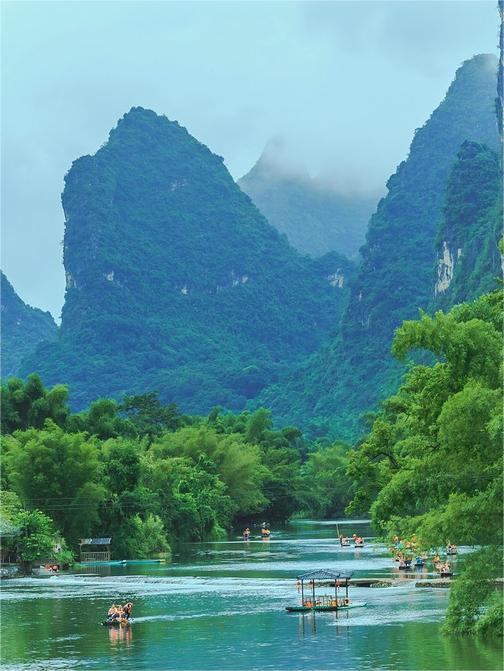Gui'lin
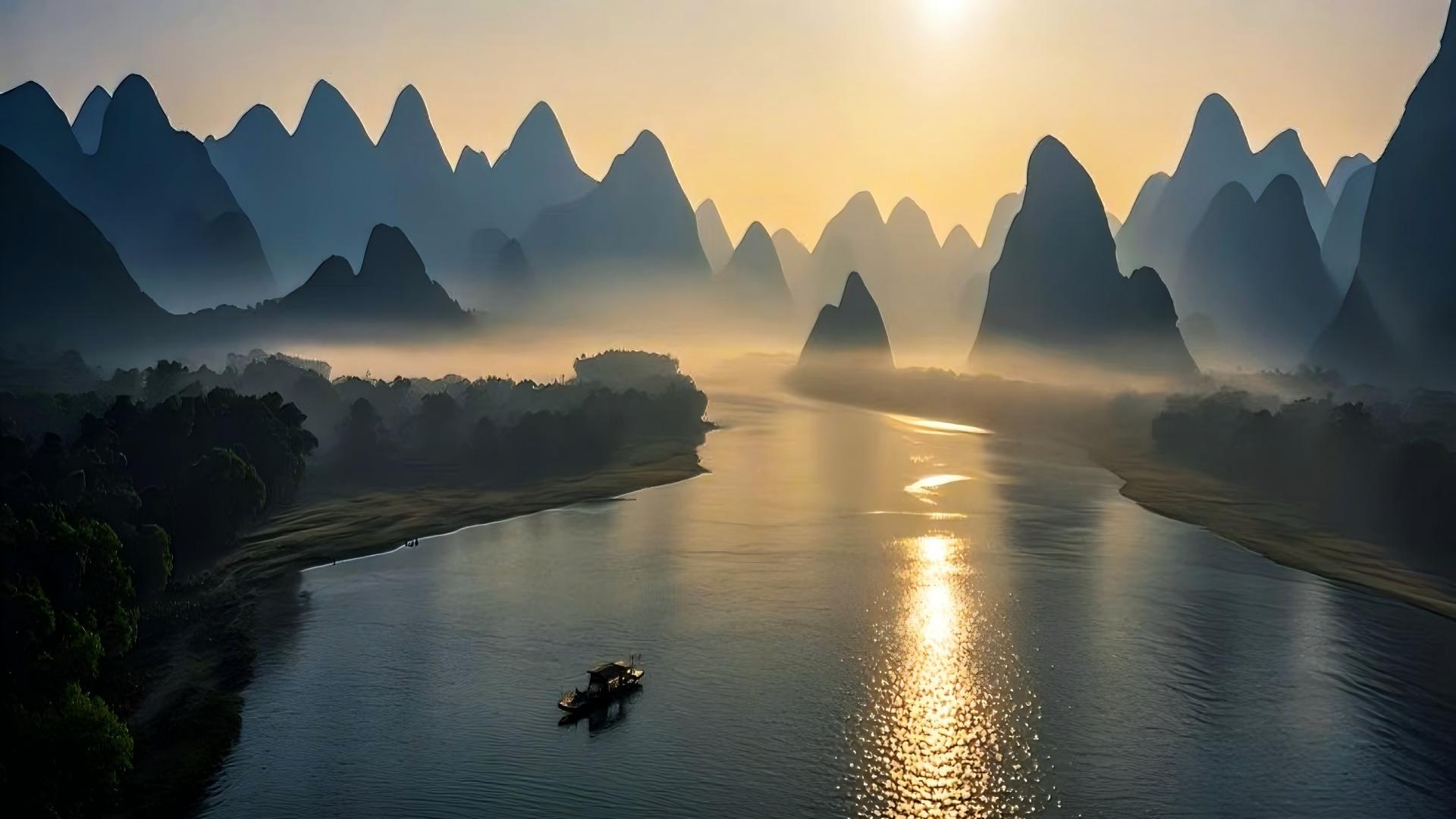
Guilin is a world-famous travel city, known for its natural beauty of mountains and waters and its profound history and culture. The Karst landscape is unique, with the picturesque Li River, the beautiful scenery of the Yulong River and the Longji Terraces. There are many historical relics, such as King Jingjiang's Mansion and Elephant Trunk Hill, which witnessed the changes over the years. Folk culture is rich and colorful, and the West Street in Yangshuo is a blend of ancient and modern Chinese and foreign styles. In addition, Guilin's food is tantalizing, with Guilin rice noodles and Yangshuo beer fish being mouth-watering. Whether it is enjoying the scenery, exploring the ancient times or tasting the fresh food, Guilin can bring tourists a unique and unforgettable travel experience!
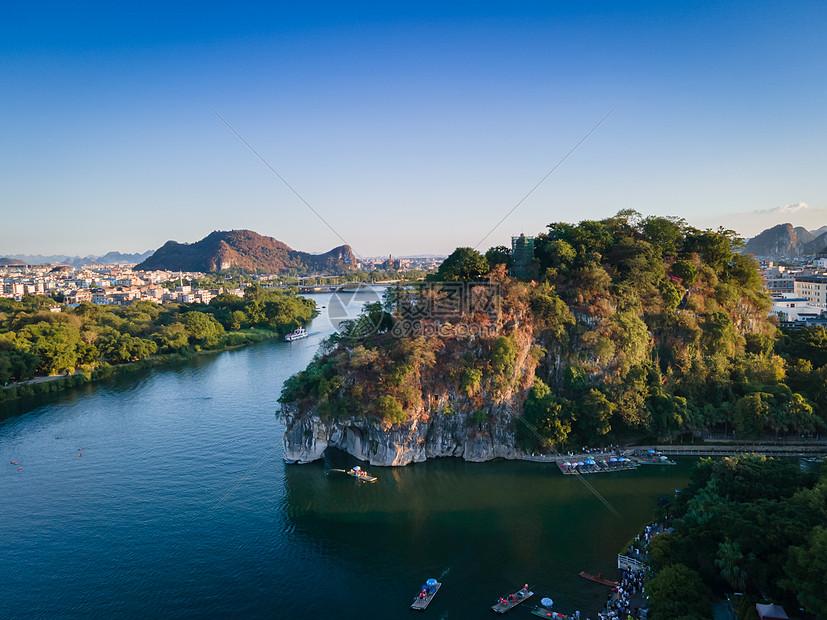
Top1.Elephant Trunk Hill Scenic Area
The Elephant Trunk Hill Scenic Area is located in the center of Guilin City at the confluence of the Lijiang River and the Taohua River. It gets its name because it resembles a giant elephant stretching out its long trunk to drink the sweet water of the Lijiang River. Shu Shu, a Langzhong in the Ministry of Works in the Qing Dynasty, wrote in "Record of Elephant Hill": "The wonders in western Guangdong lie in its mountains, the wonders of the mountains in western Guangdong lie in their rocks, and the Elephant Hill opposite the provincial capital is even more wonderful." The Elephant Trunk Hill attracts visitors with its vivid image. It is a typical representative of Guilin's landscape and was designated as the city emblem of Guilin in 1995. At the 2014 CCTV Spring Festival Gala on the Year of the Horse, the Hungarian Attraction dance troupe presented the Elephant Trunk Hill in the creative dance "Symbols of China". The main scenic spots in the area include: Elephant Hill and the Moon over the Water, Puxian Pagoda, Sanhua Wine Cellar, Love Island, and the Taiping Heavenly Kingdom Exhibition Hall in Yunfeng Temple, etc. [Elephant Hill and the Moon over the Water] "Elephant Hill and the Moon over the Water" is a major wonder of the Elephant Trunk Hill. A scholar from the north of Ji in the Song Dynasty once wrote a poem "In Response to the Rhyme of Moon - over - Water Cave": "There is a bright moon under the water, and a bright moon floats on the water. The water flows but the moon stays, and when the moon leaves, the water still flows." If you come here to enjoy the scenery of the Moon - over - Water Cave on a moonlit night, you will see a wonderful picture where the moon in the sky, in the cave and under the water set each other off. There are more than 50 precious cliff inscriptions in the cave, such as Zhang Xiaoxiang's "Poem and Preface of Chaoyang Pavilion" in the Song Dynasty, Fan Chengda's "Inscription on Restoring the Moon - over - Water Cave" and Lu You's poem notes. [Puxian Pagoda] Climbing up the winding rocks of the Elephant Trunk Hill, you can see from afar a Puxian Pagoda built in the Ming Dynasty standing among the green trees. The pagoda is 13.6 meters high and has a history of more than 400 years. It is a solid brick pagoda in the Lama style. There is a stone - engraved Bodhisattva image on the north side of the pagoda body, and the six - character mantra "Namo Puxian Pusa" is engraved on the top of the image, hence the name Puxian Pagoda. It is recorded in Buddhist scriptures that the mount of Puxian Bodhisattva is a six - tusked white elephant. Therefore, the fact that the Puxian Pagoda is built on the top of the Elephant Hill truly confirms this statement in the Buddhist scriptures. [Sanhua Wine Cellar] The Elephant Trunk Hill is a natural large wine cellar. Two - thirds of the whole hill is hollow. It is warm in winter and cool in summer, with the temperature remaining at 19 degrees Celsius all year round and the humidity above 90%. It has been used as an official cellar to store Sanhua Wine since the Song Dynasty. Sanhua Wine is colorless, transparent, fragrant and spicy. It absorbs the essence and soul of the Lijiang River and has become the representative rice - flavored wine in China, and is known as the "King of Chinese Rice Wines". The cellared wine was designated as a tribute to the imperial court as early as the Northern Song Dynasty and is one of the three treasures of Guilin. There are nearly a thousand tons of wine stored in the cave to date. [Love Island] Love Island is located on the north side of the Elephant Trunk Hill Scenic Area, facing the Lijiang River. It is another scenic spot for a distant view of the Elephant Trunk Hill. The island has a beautiful environment and lush vegetation. It was a good place for local people to date in the 1970s, so it is called "Love Island". Now it is also an exterior photography base for weddings in Guilin's landscape. Lovers make vows of love here under the witness of the Elephant Hill and the Moon over the Water.
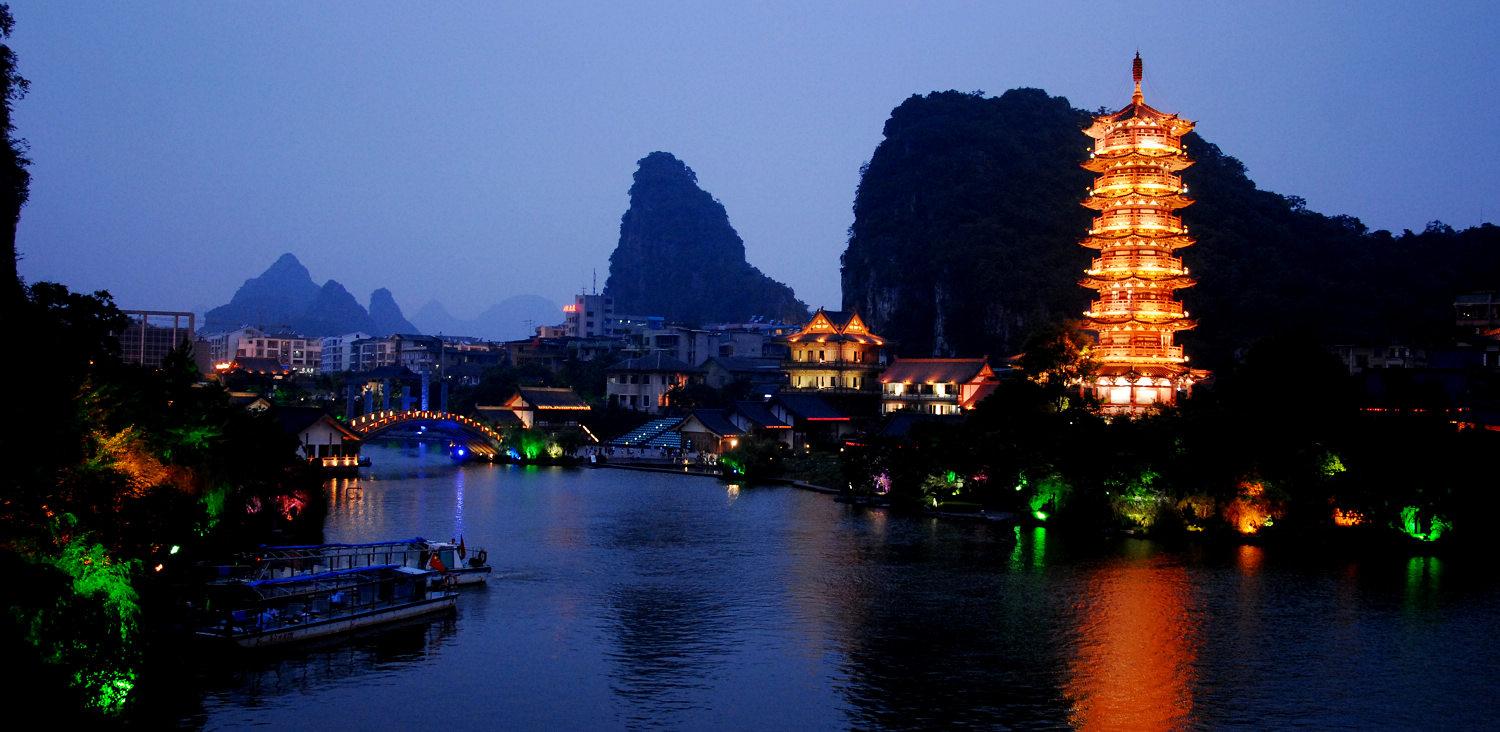
Top2.Guilin Two Rivers and Four Lakes Scenic Area
### Night Tour of the Two Rivers and Four Lakes Taking a night boat tour of the Two Rivers and Four Lakes allows you to admire the natural scenery of Shanhu Lake, Ronghu Lake, Guihu Lake, Mulonghu Lake, the urban section of the Lijiang River, and the Taohua River. You can explore the core scenic belt of Guilin and experience the环城 water system comparable to the Venetian Water City. Highlights and features: The night tour of the Two Rivers and Four Lakes is one of the classic products of our scenic area. Along the boat ride, you can not only enjoy the scenic spots, famous bridges, and mountains around the four lakes; watch the classic performances such as the thousand - year - old cormorant fishing, Yao ethnic customs, and the Half - zither and the Setting Moon. You can also cruise on the Lijiang River and the Taohua River, feel the essence of Guilin's landscape where "the city is in the scenery and the scenery is in the city", and indulge in the dazzling charm of night - time Guilin. ### Night Tour of One River and Four Lakes Taking a night boat tour of One River and Four Lakes enables you to view the natural scenery of Shanhu Lake, Ronghu Lake, Guihu Lake, Mulonghu Lake, and the urban section of either the Lijiang River or the Taohua River. You can visit the core scenic belt of Guilin and experience the环城 water system comparable to the Venetian Water City, as well as watch classic performances such as the thousand - year - old cormorant fishing, Yao ethnic customs, and the naked - eye 3D light show on the ancient city wall of Mulonghu Lake. Highlights and features: The night tour of One River and Four Lakes is one of the classic products of our scenic area. Along the boat journey, you can not only appreciate the scenic spots, famous bridges, and mountains around the four lakes; watch the classic performances like the thousand - year - old cormorant fishing, Yao ethnic customs, and the Half - zither and the Setting Moon. You can also cruise on either the Lijiang River or the Taohua River, feel the essence of Guilin's landscape where "the city is in the scenery and the scenery is in the city", and enjoy the dazzling charm of night - time Guilin. ### Night Tour of the Four Lakes Taking a night boat tour of the Four Lakes allows you to admire the dazzling night views of Shanhu Lake, Ronghu Lake, Guihu Lake, and Mulonghu Lake, as well as classic performances such as the thousand - year - old cormorant fishing. Highlights and features: The night tour of the Four Lakes is an excellent night - tour route in our scenic area. You can take a boat to explore the core scenic belt of Guilin and experience the环城 water system comparable to the Venetian Water City. Along the way, you can enjoy many scenic spots around Shanhu Lake, Ronghu Lake, Guihu Lake, and Mulonghu Lake, have a panoramic view of famous bridges and mountains; watch classic performances such as the thousand - year - old cormorant fishing, Yao ethnic customs, and the Half - zither and the Setting Moon, and indulge in the colorful night - time landscape of Guilin. ### Day Tour of One River and Four Lakes Taking a day boat tour of One River and Four Lakes allows you to view Shanhu Lake, Ronghu Lake, Guihu Lake, Mulonghu Lake, and the urban section of the Lijiang River, enjoy the picturesque natural scenery of mountains and rivers, and see the variously - shaped famous mountains. Highlights and features: Taking a day boat tour of the core scenic belt in the urban area of Guilin, you can closely admire the picturesque natural scenery of mountains and rivers. Along the way, many famous mountains such as Elephant Trunk Hill, Fubo Hill, Diecai Hill, Qixing Hill, Baoji Hill, and Old Man Hill appear one after another; famous Chinese and foreign bridges in various shapes and elegant pagodas and pavilions adorn the ancient landscape city, allowing tourists to truly feel the charm of Guilin's scenery, which is said to be the best under heaven.
- Natural Landscape
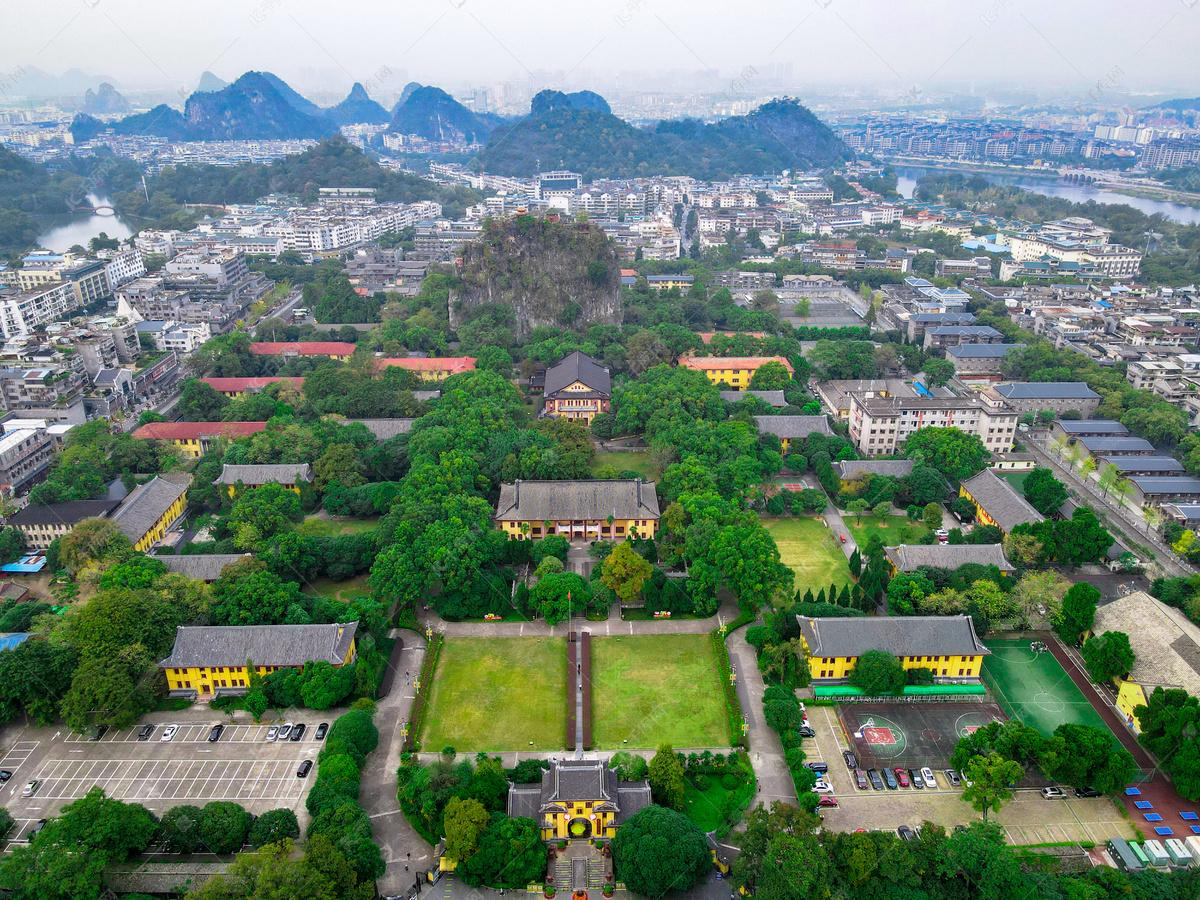
Top3.Duxiu Peak and Guilin Royal City Scenic Area
The Duxiu Peak and Prince Jingjiang's Mansion Scenic Area has a history dating back more than 600 years to the Hongwu period of the Ming Dynasty. It was once a vassal city built by Zhu Yuanzhang for his grand-nephew Zhu Shouqian. Today, it is a national 5A-level scenic area in Guilin, and Duxiu Peak is its landmark attraction. The natural scenery and historical and cultural landscapes in the scenic area complement each other, creating a unique blend of "scenery within the city and the city within the scenery". It is also a carrier of Guilin, a world-famous city with rich history and beautiful landscapes. The famous ancient saying "Guilin's scenery is the best under heaven" that has spread around the world originated from the cliff of Duxiu Peak. It encompasses three major historical and cultural systems of Guilin and is a typical representative of Guilin's history and culture. Entering the scenic area is like opening the door to Guilin's historical and cultural heritage. Therefore, the famous saying "Guilin's scenery is the best under heaven; after visiting the Prince Jingjiang's Mansion, you'll know Guilin well" has been widely spread. As early as the Southern and Northern Dynasties period, the great literary scholar Yan Yanzhi studied and composed poems at the foot of Duxiu Peak, initiating the literary style in the Lingnan region. In the Tang Dynasty, the first official school in Guangxi's history was established here. In the Song Dynasty, Wang Zhenggong engraved the famous saying "Guilin's scenery is the best under heaven" on Duxiu Peak, which has become a representative advertising slogan for Guilin. In the Ming Dynasty, Liu Bowen, the military advisor of Zhu Yuanzhang, took a fancy to this auspicious place of Duxiu Peak, and later the Prince Jingjiang's Mansion was built. In the Qing Dynasty, the Prince Jingjiang's Mansion was converted into the Guangxi Examination Hall, becoming a large-scale imperial examination venue in the southwest region. A total of 585 Jinshi (successful candidates in the highest imperial examination) and 4 Zhuangyuan (Number One Scholar) emerged from here, and one of the Zhuangyuan even achieved the rare feat of "winning all three levels of the imperial examination". During the Republic of China, when Sun Yat-sen launched the Northern Expedition and came here, he set the Prince Jingjiang's Mansion as the headquarters of the Northern Expedition. In 1954, Guangxi Normal University moved in. Duxiu Peak and Prince Jingjiang's Mansion is not only a place with outstanding people but also the political, economic, and cultural center of Guangxi throughout history. [Duxiu Peak] Duxiu Peak is located in the center of Guilin. It stands alone, rising straight from the ground. It is the leader among the mountains in Guilin, like a king among the mountains. Standing on the peak, you can overlook the entire city of Guilin, with a magnificent view similar to the feeling of "all the other mountains appear so small under the sky" described in the famous poem. It is honored as "a pillar supporting the southern sky". As early as the Southern Dynasties period, the great literary scholar Yan Yanzhi wrote a poem "There's nothing like the solitary peak, towering majestically in the city" to describe the magnificent momentum of Duxiu Peak. [Prince Jingjiang's Mansion] The Prince Jingjiang's Mansion is a well-preserved vassal prince's residence site in China and the core tourist attraction in the Duxiu Peak and Prince Jingjiang's Mansion Scenic Area. The Prince Jingjiang's Mansion Museum, also known as the "Chengyun Hall", was the place where ancient princes handled government affairs. Now, the museum displays the history of the changes of the Prince Jingjiang's Mansion and the whole of Guilin. Tourists can use high-tech holographic projections and 3D projections to gain an in-depth understanding. They can also experience the ancient rubbing technique by themselves at the "Mansion Rubbing Workshop". [Cliff Inscriptions on Duxiu Peak] There are about 200 cliff inscriptions on the cliffs of Duxiu Peak, all preserved from past dynasties. The famous ancient saying "Guilin's scenery is the best under heaven" comes from here. A large number of precious Buddha and Taishui (a kind of inscriptions related to the Chinese zodiac) inscriptions, as well as the Five - Blessings series that appeared on the 2017 CCTV Spring Festival Gala, all come from the cliff inscriptions on Duxiu Peak. They are now national key protected cultural relics. [Secret Rubbings of the Prince's Mansion] The Secret Rubbings of the Prince's Mansion has a history of over a hundred years. It is a color rubbing process developed by Zhu Zuojing, the third - generation Prince Jingjiang. It has now been included in the intangible cultural heritage. Tourists can experience the ancient rubbing technique here, and learning to make the Secret Rubbings of the Prince's Mansion is of great value for the inheritance and development of Chinese history, culture, and folk art.
- Historical culture

Top4.Longji Terraced Fields
Longji Terraced Fields is a large-scale terraced field group in Guilin area. There are several ancient villages of ethnic minorities here, where the Zhuang and Yao ethnic groups live. The well - known villages are Ping'an Village, Jinkeng Grand Village, Ancient Zhuang Village and Huangluo Yao Village. It is convenient to drive to Longji Terraced Fields. Most tourists come here for hiking, enjoying the scenery and taking photos. They can also taste the local farmhouse dishes and stay in the beautiful homestays to experience the ethnic minority customs. Ping'an Zhuang Terraced Fields: A classic picture of rural scenery When visiting Longji Terraced Fields, Ping'an Village is a classic destination. It has been developed for tourism earlier, and the facilities for eating, drinking and entertainment are more complete. There are 170 households and more than 700 people in this Zhuang village, mostly Zhuang people with the surnames of Liao. The terraced fields are mostly composed of small plots, with a quiet and beautiful scenery. In autumn when the crops are mature, the terraced fields are covered with golden yellow, and the autumn scenery of the terraced fields is especially beautiful. The most famous viewing platforms in the scenic area are "Seven Stars伴月" and "Nine Dragons and Five Tigers", but you need to use a little imagination when visiting. "Seven Stars伴月" refers to the seven small hillocks left when the fields were opened in the past, which are like seven little stars accompanying the crescent - shaped terraced fields. "Nine Dragons and Five Tigers" refers to the nine small mountain ridges branching out from the main vein of Longji here, and the five slightly protruding small mountain tops are like five tigers, surrounding the terraced fields and guarding this land. Longji Ancient Zhuang Village Terraced Fields: An original ecological beauty with a long history Longji Ancient Zhuang Village is one of the ancient villages with a long history in the scenic area, dating back to the Wanli period of the Ming Dynasty. There are more than 200 households and more than 1000 people in this Zhuang village, mostly Zhuang people with the surnames of Pan, Liao and Hou. Due to the poor transportation and late development, the original terraced field landscape is well - preserved here. The traditional stilted wooden buildings distributed along the mountain ridge are so original, which is a unique scenery. When visiting, you can walk up along the bluestone road, appreciate the stone bridges, steles and stone carvings that tell the history of the past. Pass by the "Ancestral Field" and reach the "Long Gully" viewing platform to overlook the beautiful scenery of the whole village. When going down the mountain, you can stand at the "Flying Dragon Descending to the River" viewing point to see the terraced fields like a huge dragon winding down to Jinjiang, which is very spectacular. Jinkeng Red Yao Terraced Fields: Majestic curves of the fields In addition to the spectacular terraced field scenery, the long hair of the Red Yao girls here is also a beautiful scenery. There are 245 households and more than 1130 people in Jinkeng Grand Yao Village, mostly Yao people with the surname of Pan. When visiting, you can choose to climb up the mountain along the stone path. First, go to the "Thousand - layer Ladder" viewing platform to see the overlapping terraced fields piling up to the clouds like a ladder, which is very magnificent. Then keep going up, there is the "Xiaoshan Shao Yue" viewing platform, where you can overlook the panoramic view of the terraced fields, which is extremely spectacular. If you want to go to the "Golden Buddha Peak" viewing platform to enjoy the magical scenery of the whole mountain sitting like a Maitreya Buddha, you need to take the cable - car directly from Jinkeng Grand Village at the foot of the mountain. Tour routes: One - day tour: Ping'an Zhuang Terraced Fields or Ancient Zhuang Village Terraced Fields or Jinkeng Grand Village + Huangluo Yao Village. If you only have one day to visit Longji Terraced Fields, it is recommended that after buying the scenic area ticket, go straight to a village to enjoy the scenery and taste the local farmhouse food. Two - day/multi - day tour: Jinkeng Red Yao Terraced Fields - Ping'an Zhuang Terraced Fields - Longji Ancient Zhuang Village Terraced Fields. If you plan to stay for a few more days, you can visit the scenic spots in the order from the farthest to the nearest from the urban area of Guilin. Appreciate the terraced fields, visit the ancient villages and experience the ethnic minority customs. Watching the sunrise and sunset: Watching the sunrise over the terraced fields is a must - do for many tourists. Even many photography enthusiasts come here just for the sunrise. There are three sunrise and sunset viewing points in Jinkeng Red Yao Terraced Fields. "Xiaoshan Shao Yue" is a viewing point. It is far away, but with a wider view. It's great for both watching the sunrise and sunset. Many promotional videos of Longji Terraced Fields are shot here. The "Thousand - layer Ladder" viewing platform is closer to the foot of the mountain. You can see the Yao villages here and feel the integration of humanities and nature, which is suitable for watching the sunset. "Golden Buddha Peak" is a good place for shooting the sunset. Since it was far away in the past, there were not many people taking photos here. In recent years, a cable - car that goes directly from the entrance of Jinkeng Grand Village Scenic Area to the Golden Buddha Peak has been opened, which makes it much more convenient for people to come here to take photos.
- Natural Landscape
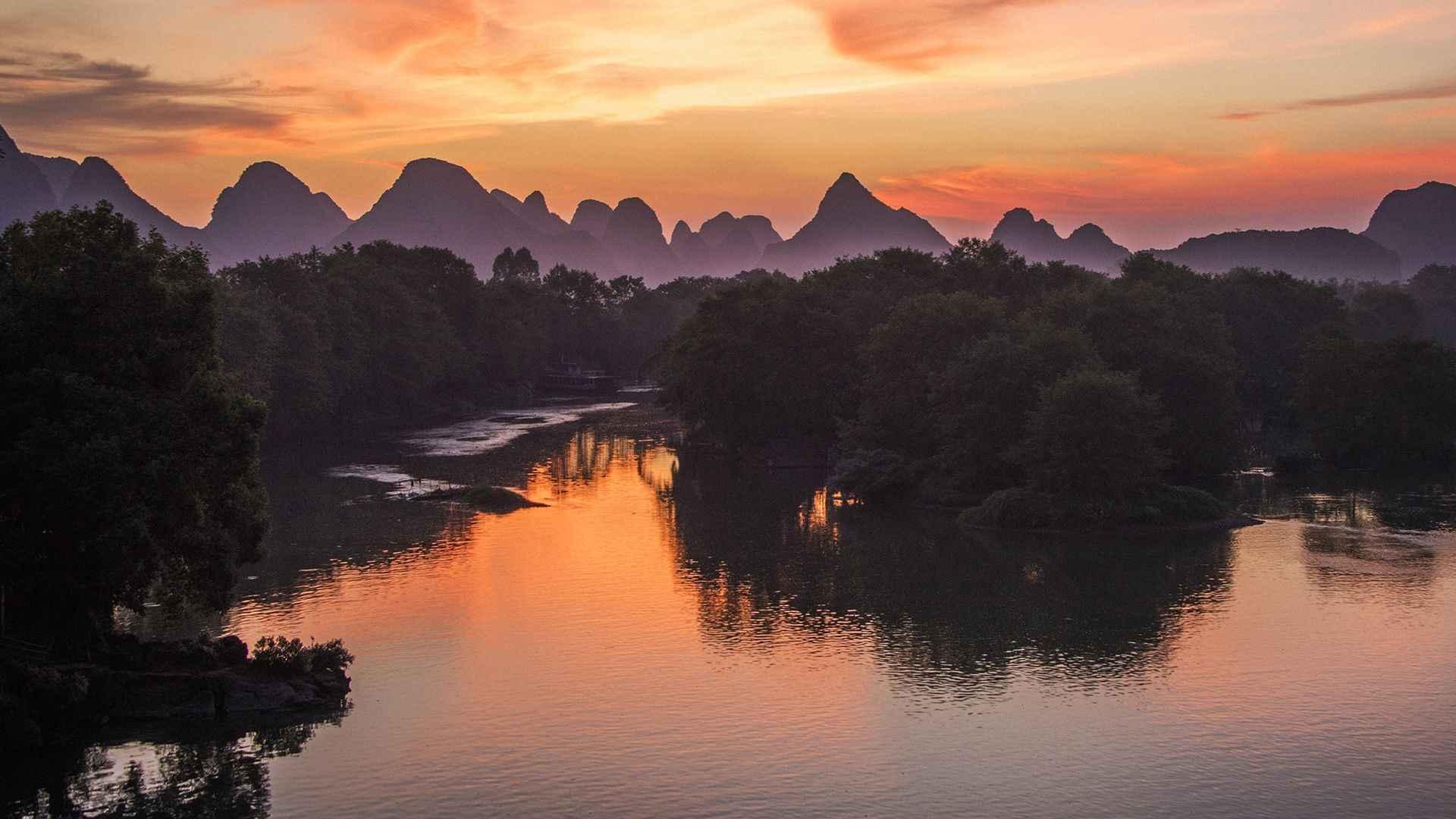
Top5.Lijiang River Scenic Area
A passage in a primary school Chinese textbook titled "The scenery of Guilin ranks first under heaven" refers to touring the Li River. The mountains on both sides of the Li River are majestic, towering, and come in various shapes, which represent the essence of Guilin's scenery. "The hundred - mile Li River is like a hundred - mile art gallery." Every view here is a typical Chinese ink painting. In the Li River Scenic Area, green peaks line the banks, green waters wind around, there are canyon cliffs, hanging springs and flying waterfalls, oases and dangerous shoals, as well as strange caves and beautiful stones. The scenery is ever - changing. Dozens of well - known scenic spots are distributed along the river: Wujiaotan, Nine Oxen and Three Islets, Bat Mountain, Wife - waiting Stone, Caoping Scenery, Crown Cave, Embroidery Mountain, Half - way Strange Ferry, Immortal Pushing the Mill, Yangdi Scenery, Carp Hanging on the Cliff, Langshi Wonder, Halong Bay, Chicken Coop Mountain, Eight Immortals Crossing the River, Five - Finger Mountain, Turtle Climbing the Hill, Nine - Horse Mural Hill, Huangbu Reflection (the background of the 20 - yuan RMB note), Camel Crossing the River, Chaoban Mountain, Xingping's Beautiful Scenery, Snail Mountain, Fishing Village, Dragon Head Mountain and so on. Generally, the main ways to tour the Li River include taking a boat, a bamboo raft, or hiking, including three - star and four - star Li River cruises, bamboo raft tours on the Li River, and big - boat tours to Xingping Fishing Village.
- Natural Landscape

Top6.Impression Sanjie Liu: A Real - Scene Performance on the Landscape
### I. *Impression·Liu Sanjie* The large-scale real-scenery performance on natural landscape *Impression·Liu Sanjie* is directed by renowned directors Zhang Yimou, Wang Chaoge, and Fan Yue, and is masterminded by national - level playwright Mei Shuaiyuan. It integrates the beautiful scenery of the Li River, the cultures of ethnic minorities in Guangxi, and the creations of top - notch Chinese artists. It is the first large - scale real - scenery performance with a brand - new concept in China, pioneering the way for large - scale real - scenery performances in the country and serving as a successful model for the domestic cultural industry. *Impression·Liu Sanjie* is directed by Zhang Yimou, Wang Chaoge, and Fan Yue, and masterminded by Mei Shuaiyuan. The four key creative personnel collaborated to complete it. It is based on the legend of Liu Sanjie, the singing fairy of Guangxi, but not limited to her story alone. It uses the composition and techniques of Chinese traditional Chinese paintings and integrates real mountains and waters. Combining the unique rhythms and tones of ethnic minority songs, it fuses and presents the natural scenery along the Li River, the daily work and life of fishermen and villagers, and the folk customs of ethnic minorities through visual effects and artistic arrangements. The whole performance has no continuous story line and no accurate translation of the lyrics. Instead, with Liu Sanjie as the starting point, through freehand brushwork - style pictures and well - known mountain songs, it representatively showcases the customs of ethnic minorities such as the Zhuang, Yao, Miao, and Dong in Guangxi, as well as the diverse aspects of life around the Li River. Since its public performance in March 2004, *Impression·Liu Sanjie* has had more than 8,000 shows in total and has become a benchmark for real - scenery performances in China. ### II. Introduction to the Chapters of *Impression·Liu Sanjie* #### Prologue: Legends of Mountains and Waters This is the origin part of the performance. Classic scene: The mountain - water stage lights up, and Liu Sanjie comes on a bamboo raft. "Singing mountain songs, singing here and there..." The mountain songs rise along the water, passing through the mountains, and the night sky writes the dream of the legend. Liu Sanjie, the singing fairy, comes on a boat and sings loudly, born from the mountains and waters. #### Chapter One: Red Impression / Mountain Songs This is the charm part of the performance. Classic scenes: Singing duels and red silk ribbons. Young men and women of ethnic minorities wave torches and sing mountain songs across the river, expressing their respect for the mountains and rivers and the affection between young people, representing the traditional culture of singing duels among local ethnic minorities. Fishermen in straw capes and hats wave bamboo poles and row freely on the Li River. The waving red silk ribbons symbolize the dense and heavy fishing nets. Combined with the diverse formations of bamboo rafts, it fully shows the daily hard work of Li River fishermen, conveying the impression of the harmonious coexistence between local human life and natural scenery. #### Chapter Two: Green Impression / Homeland This is the life part of the performance. Classic scene: Grand Song of the Dong ethnic group (performed live by Dong girls). With the setting sun and cooking smoke, cowherd boys skip and lead the cattle herds. Cormorants sit obediently on bamboo rafts and fish with fishermen. Village women wash clothes by the river, and teenagers play and laugh at the village entrance... These scenes outline the daily life of the people along the Li River. Scenes of the countryside reflect Liu Sanjie's living situation, making people feel the beauty and tranquility of the hometown of mountain songs. #### Chapter Three: Golden Impression / Fishing Lights This is the night - time part of the performance. Classic scene: Fishing lights on the Li River. The long - burning oil lamps on the fishermen's bamboo rafts are like twinkling stars in the sky, known as the fishing lights on the Li River. With the warm light in the night, it records the hard work and harvest of fishermen, presenting the natural inheritance of the simple way of labor. #### Chapter Four: Blue Impression / Love Songs This is the love part of the performance. Classic scenes: Dance of the crescent fairies, bathing, and wedding ceremony. The fairies guarding the mountains and waters dance on the crescent moon, lighting up the Li River at night and gently blessing every household. Girls bathe and change clothes by the river, seeing off their sisters who are about to get married. They slowly dress the bride in wedding clothes and bid farewell reluctantly. The bride dresses up neatly, waves goodbye to her family, steps onto the groom's boat, bows three times to the mountains and waters and relatives, and bids farewell affectionately. #### Chapter Five: Silver Impression / Grand Ceremony This is the magnificent part of the performance. Classic scene: Silver ornaments. In the darkness, ethnic minority girls wearing special silver - lamp costumes (Miao ethnic group's grand costumes) hold hands and slowly step onto the Li River. They shine with the brilliant colors of the festival. Whether in a group, in turns, in small groups, or alone, through the change of formations and the combination of bright and dim lights, they form a picture with the mountains and waters and dance with the heaven and earth, abstractly showing the magnificent and colorful cultural customs and festival atmosphere of the local area. #### Epilogue: Ode to Heaven and Earth This is the curtain - call part of the performance. Classic scene: All the performers take their curtain calls (the fisherman performers are from five surrounding natural villages, namely Maozicun, Xingpingcun, Tianjiahe Village, Mushancun, and Mushanzha Village). The fishing lights fade away, the lights go out, but Liu Sanjie's mountain songs still echo between heaven and earth. *Impression·Liu Sanjie* expresses gratitude to the mountains and waters and to guests from all over the world! ### III. Highlights of *Impression·Liu Sanjie* #### 1. Unique Natural and Geographical Features The reason why *Impression·Liu Sanjie* is so shocking is the support and influence of the landscape in Yangshuo, Guilin. With a two - square - kilometer Li River water area and twelve background mountains led by Shutong Mountain, it is a world - famous real - scenery theater on natural landscape, far different from traditional stage settings. #### 2. Representative Ethnic Themes *Impression·Liu Sanjie* representatively showcases the customs and diverse aspects of life of ethnic minorities such as the Zhuang, Yao, Miao, and Dong. In the performance, there are traditional on - site singing duels of Guangxi ethnic minorities, local - characteristic fishing and farming, weddings, festival ceremonies, and details of the original - ecological daily life. #### 3. Widely - Spread Liu Sanjie Culture In 1961, the movie *Liu Sanjie* visualized and dramatized the story of Liu Sanjie, the singing fairy, becoming a classic symbol and a memory of the years in people's hearts. *Impression·Liu Sanjie* refers to and sorts out various materials, striving to absorb widely. It integrates and presents the cultural essence represented by Liu Sanjie through artistic means and poetic arrangements, making Liu Sanjie a cultural business card of Guangxi. #### 4. High - end Star - Studded Artistic Creation Team *Impression·Liu Sanjie* is the world's first large - scale real - scenery performance on natural landscape with a new concept. It is directed by renowned directors Zhang Yimou, Wang Chaoge, and Fan Yue, and masterminded by national - level playwright Mei Shuaiyuan. The performance plan was revised 109 times over 5 years and 5 months. 67 well - known Chinese and foreign artists participated in the creation. The performance lasts 70 minutes and involves more than 600 performers.
- Artistic charm
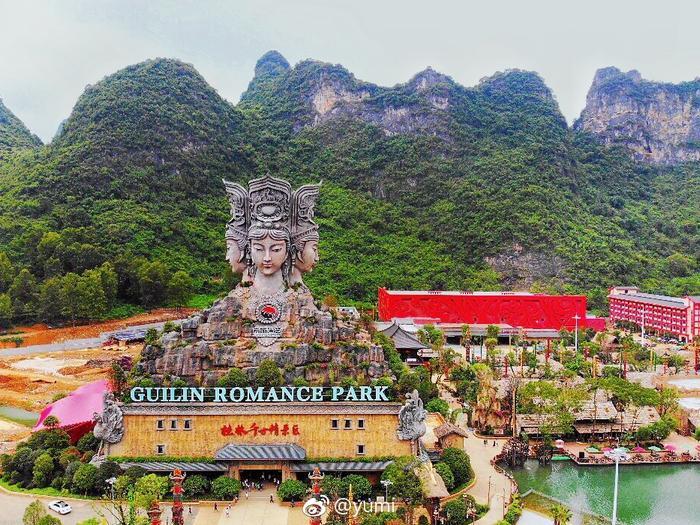
Top7.Guilin Eternal Love
The Guilin Eternal Love Scenic Area, jointly developed by Songcheng Performing Arts and Guilin Tourism Co., Ltd., recreates the historical culture and ethnic customs of Guilin. It is suitable for people of all ages and can be visited in both sunny and rainy days. Everything in the scenic area is centered around tourists. It has the No. 3 Secret Realm Tourist Complex with over ten thousand square meters of fully air - conditioned indoor space and a covered corridor. The giant statue of the Song Fairy is imposing and blends seamlessly with the Guilin landscape. It is the personification of the kind - hearted people in the land of Guangxi. High - tech and children's experience projects such as the haunted house, the Museum of the Movie "Along the River During the Qingming Festival", and the Wonderful Street are full of fun. "Guilin Eternal Love" uses advanced high - tech means such as sound, light, and electricity, as well as stage machinery. In the three - dimensional space of land, water, and air, it sings the legend of truth, goodness, and beauty that has traversed time in the land of Guangxi. It brings the Guangxi culture hidden beneath the eight - hundred - li Lijiang River landscape into the view of everyone, recreating a tragic love story of three lifetimes in Guilin. There are also wonderful performing arts and technology shows such as "The Earthquake", "Tibetan Bonfire Dance Carnival", and "Ethnic Flash Mob Show".
- Artistic charm
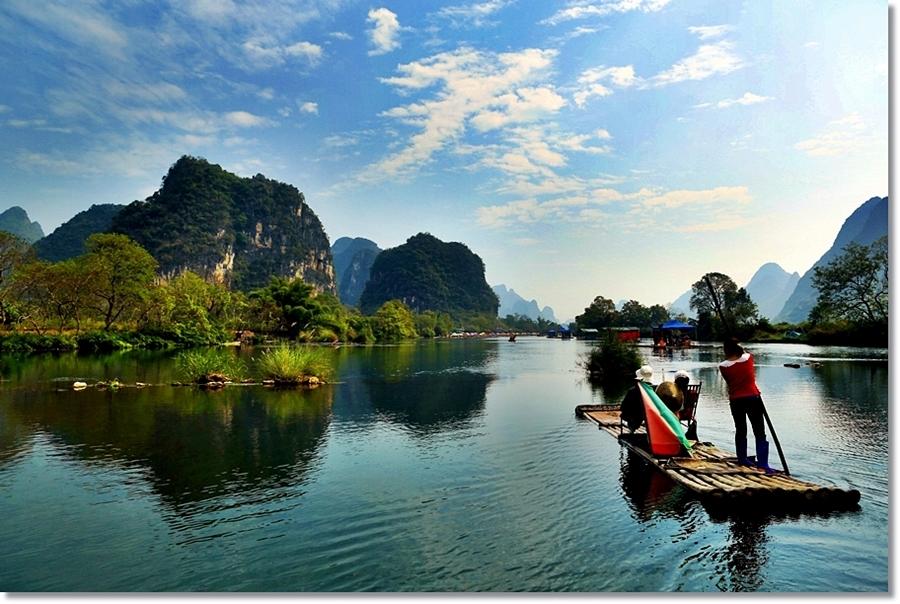
Top8.Yulong River Rafting
Rafting is a recommended way to visit the Yulong River. Taking a bamboo raft and drifting on the Yulong River, you can enjoy the picturesque landscapes on both banks, which is very relaxing. Sit on the slowly moving bamboo raft and admire the continuous mountains and idyllic scenery on both sides. Along the way, you will also pass by small towns and many ancient bridges, with a clear river surface beneath you, making for a quiet and relaxing experience. There are 6 docks along the Yulong River rafting route, and the docks are in the following order: Jinlongqiao Dock, Yulongqiao Dock, Jiuxian Dock, Jima Dock, Shuiedi Dock, and Wanjing Dock.
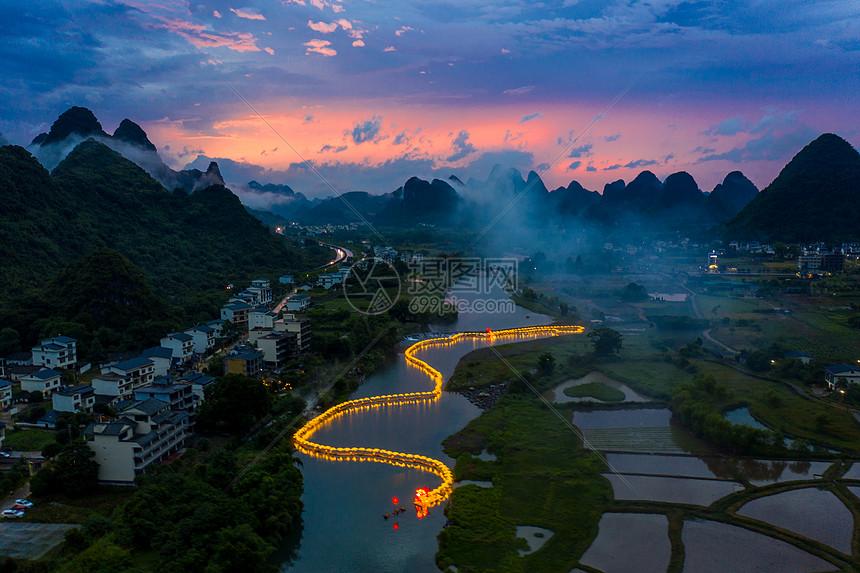
Top9.Yulong River Scenic Area
The Yulong River is a tributary of the Li River within Yangshuo. The river water is as clear as a mirror, and you can easily take photos that look like Chinese landscape paintings. Compared with the scenery of the Li River, the scenery of the Yulong River is more gentle and it is known as the "Little Li River". The bamboo raft drifting on the Yulong River is very famous. You can sit on the raft and savor the beautiful riverside landscapes of mountains, waters and rural fields. You can take a bamboo raft at the drifting piers and cruise on the Yulong River. With picturesque landscapes on both banks, it is really enjoyable. The piers include Jinlongqiao, Yulongqiao, Jiuxian, Jima, Shui'e Di, Gongnongqiao, Wanjing, etc. If you choose to drift on the upper section of the Yulong River (from Jinlongqiao to Jiuxian), the drifting time is about 1.5 hours, and you will pass by Yulongqiao and Xiniu Pond along the way. Most of the tourists on the lower - section drifting (from Chaoyang/Jima to Gongnongqiao) are those on group tours.
- Natural Landscape
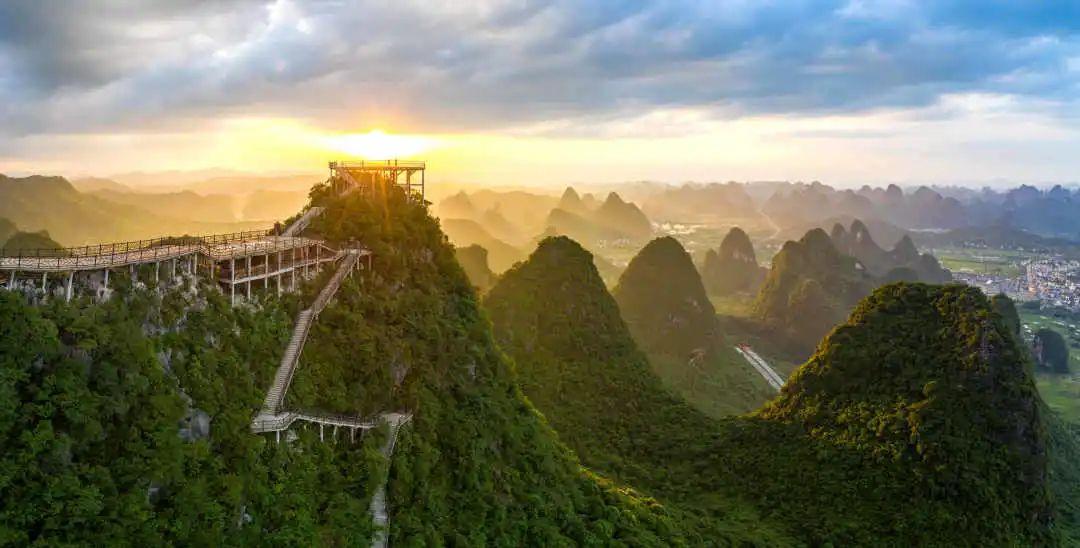
Top10.Ruyifeng Ropeway Scenic Area
I. Basic Information Yangshuo Ruyi Peak Cableway Scenic Area is an aerial sightseeing and leisure tourism project jointly invested and developed by Shaanxi Junjing Cableway Investment and Construction Co., Ltd., a subsidiary of Shaanxi Tourism Group Co., Ltd., and Guilin Ruisheng Tourism Development Co., Ltd. The total investment of the project is 260 million RMB. The scenic area is located in Mengcun, Gaotian Town, Yangshuo County, adjacent to National Highway 321. It is 5 km away from the Gaotian Exit of the Baotou - Maoming (Guilin - Wuzhou) Expressway, and about 5 km away from core scenic areas in Yangshuo such as the Yulong River, Moon Hill, and Ten - Mile Gallery, as well as Lipu Yinziyan Scenic Area. II. Project Construction The project aims to build a natural mountain - top park in Yangshuo. It consists of the natural karst landscape of "Three Peaks and Two Valleys" (Yuanbao Peak, Ruyi Peak, Xianglian Peak, Caixi Valley, and Baihua Valley), along with creative landscapes such as the cableway, Ruyi Cloud Top Observation Platform, Ruyi Suspension Bridge, Forest Walkway, Glass Skywalk, and Digital Experience Hall. Tourists can enjoy an all - round aerial view of Yangshuo's unique karst peak forest landform, pass through the forest to admire the landscape of Guilin, and experience the fun of walking in the forest! The Ruyi Peak Cableway is 2,012 meters long. The lower cableway station is located in the Xingtianle International Tourism Resort, and the upper station reaches directly to Yuanbao Peak. The vertical height difference is 242 meters. The one - way transport capacity can reach 2,000 people per hour, and the speed is adjustable from 0.5 to 6 meters per second. The cableway equipment is imported from the French company POMA. It is a single - line circulating detachable grip 8 - person gondola cableway. The overall operation and safety systems adopt advanced passenger cableway technology and a full - process digital automatic control system, with technical indicators reaching the world - class level. III. Business Situation and Major Achievements Since its opening on January 6, 2020, the Ruyi Peak Cableway Scenic Area has been operating well. During the operation period, the goal of zero production safety accidents has been achieved. There have been no major tourist complaints, no fault - related cableway stoppages, and no fire or other personal injury safety accidents. In November 2020, the Ruyi Peak Cableway Scenic Area was awarded the honor of "Top Ten Scenic Areas in Guilin" by the Guilin Bureau of Culture, Radio, Television, and Tourism. On December 24, 2021, it was rated as a "Contract - Abiding and Credit - Valuing" enterprise in the Guangxi Zhuang Autonomous Region in 2020 by the Guangxi Zhuang Autonomous Region Market Supervision Administration. On December 28, 2021, the Ruyi Peak Cableway Scenic Area was awarded the certificates of "Enterprise with Standardized Production Safety" and "Enterprise with 5S Service Quality" by the China Cableway Association. In 2022, it was rated as one of the "Top Ten Internet - Famous Scenic Area Check - in Spots in Guilin" and one of the "Top Ten Check - in Spots for Celestial and Climatic Landscapes in Guangxi", and was included in the "World Karst Scientific Research and Education Route". IV. Tour Route Take the cableway up the mountain - Admire Yuanbao Peak - Experience the Ruyi Suspension Bridge - Overlook Yangshuo from the Ruyi Cloud Top - Admire the peak forest landscape on the forest walkway - Experience the glass skywalk - Visit the "Singing and Touring Guilin" Experience Hall - Return down the mountain. 1. Ruyi Peak Cableway The horizontal distance is 2,012 meters, the height difference is 241 meters, and the one - way transport capacity is 2,000 people per hour. The cableway system equipment is designed and manufactured by the French company POMA. The overall operation and safety systems adopt advanced passenger cableway technology and a full - process digital automatic control system, with technical indicators reaching the world - class level. 2. Ruyi Suspension Bridge The bridge is 142.4 meters long, the bridge deck is 2 meters wide, and the bridge deck is 58 meters above the valley bottom. Standing on the bridge, you can have a panoramic view of the Yangshuo peak forest. The slight swaying in the air provides an exciting and wonderful experience. 3. Ruyi Cloud Top Ruyi Peak is named because its ridge resembles a ruyi, a traditional auspicious object in Chinese culture. The Ruyi Cloud Top is a 360° observation platform at the highest point of Ruyi Peak. It is a auspicious place for people to pray for wishes to come true and a great place to overlook the spectacular karst peak forest. 4. Forest Walkway The forest walkway winds between the peaks and valleys, with a total length of 246 meters and a central height of 32.5 meters. It is composed of a steel frame structure inlaid with tempered glass and steel grating. From a distance, it looks like a graceful "rainbow" between the peaks and a floating ribbon in the forest. Walking on it, you can have a full view of the beautiful peak forest scenery and fully feel the fun of traversing the original forest in the air. 5. Glass Skywalk The glass skywalk is built along the cliff, 138 meters long and 1.8 meters wide. Walking on it is exciting and challenging. Looking into the distance, you can see the green peak forest, curling smoke from the chimneys, and the idyllic scenery like a painting. 6. "Singing and Touring Guilin" Experience Hall Located at the upper station of the Ruyi Peak Cableway, it is an immersive digital experience space that uses digital technology and environmental art to display spatial creativity and intelligent interactive experiences. It creatively integrates the karst landscape and ethnic customs, making tourists feel as if they are walking in a dynamic picture of Guilin's landscape, creating a wonderful feeling of "people strolling in the painting".
- Outdoor adventure

Top1.Longsheng Longji First Floor Art Inn
Inside the Ping'an Zhuang Rice Terraces Scenic Area, Longji Town (near the Ping'an Parking Lot)
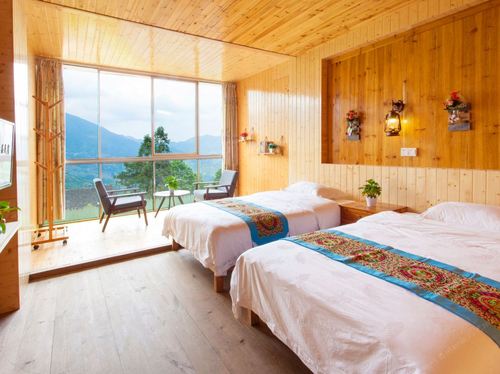
Top2.Longsheng Xiyu Boutique B&B
Next to Viewing Platform No. 1, Tiantouzhai, Dazhai Village, Longji Town, Longsheng

Top3.TOWO Select Hotel (Longsheng Longji Terraced Fields Branch)
Southwest of Longsheng Jingyue Resort Hotel (Seven Stars伴月Observation Deck Branch) 注:“七星伴月”英文中没有完全对应的表达,这里暂时保留拼音,若有更合适的英文说法可根据实际情况替换。
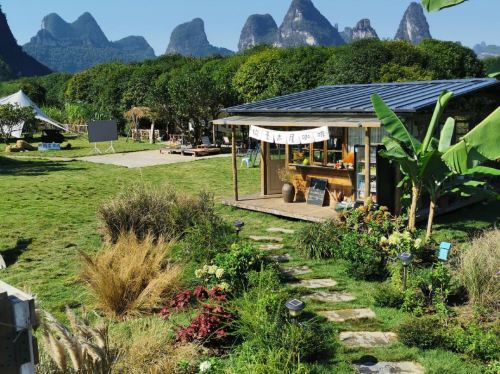
Top4.Shuimoju Homestay (Branch No. 1, Ancient Town Pedestrian Street)
No. 132, Dahebei Village, Xingping Town

Top5.Yangshuo Yangdi · Courtyard Hotel
Inside the scenic area of Yangdi Wharf in Shuiyantou Village
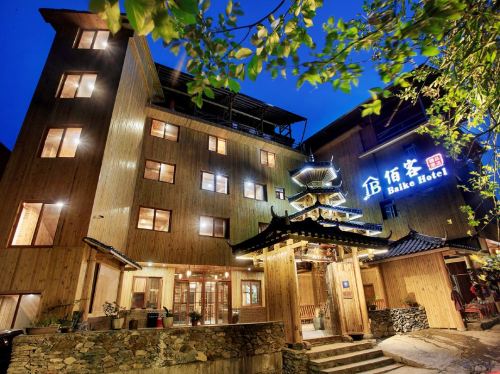
Top6.Baike Boutique Hotel (Longji Ping'anzhai Store)
Inside the Ping'an Zhuang Terrace Field Scenic Area, No. 1, Ping'an Village, Heping Township
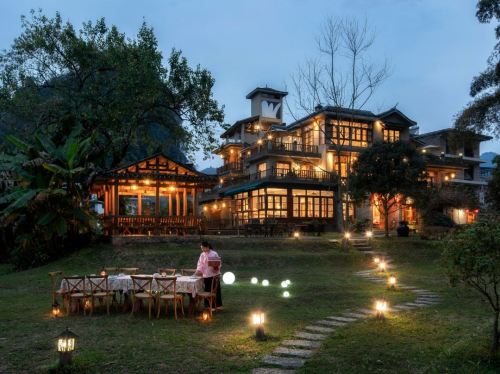
Top7.Yangshuo Moon Dance Resort Hotel
No. 1, Fenglou Village, Gaotian Town
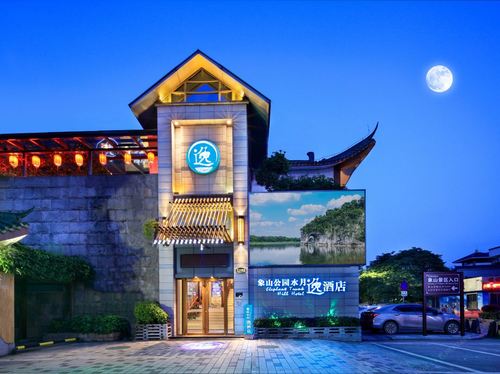
Top8.Xiangshan Shuiyue Yi Hotel
No. 52, Minzhu Road (Entrance 1, Xiangshan Park)
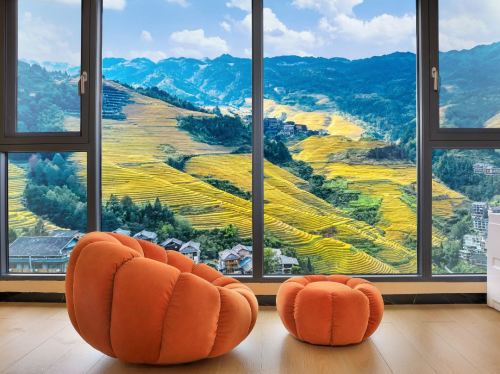
Top9.In the Paddy Fields · Enjoy the Panoramic Beauty Homestay (Longji Terraced Fields No. 2 Observation Deck Store)
No. 440, Lower Zhuangjie Group, Dazhai Village, Longji Town

Top10.Xing'an Youshu Guesthouse
Intersection of County Road 407 and County Road 379

